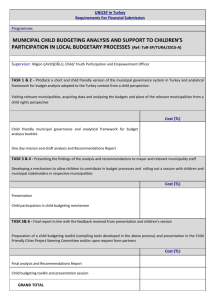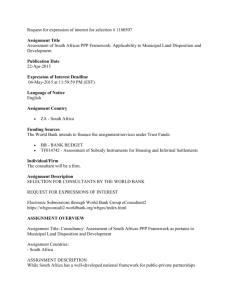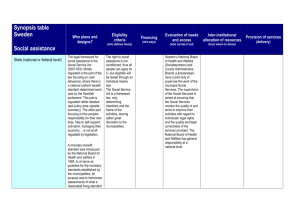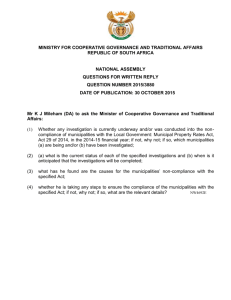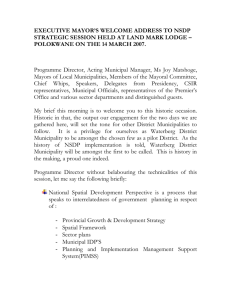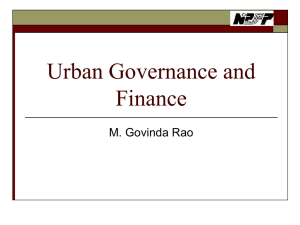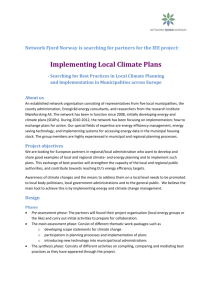Reinventing local government in South Africa
advertisement
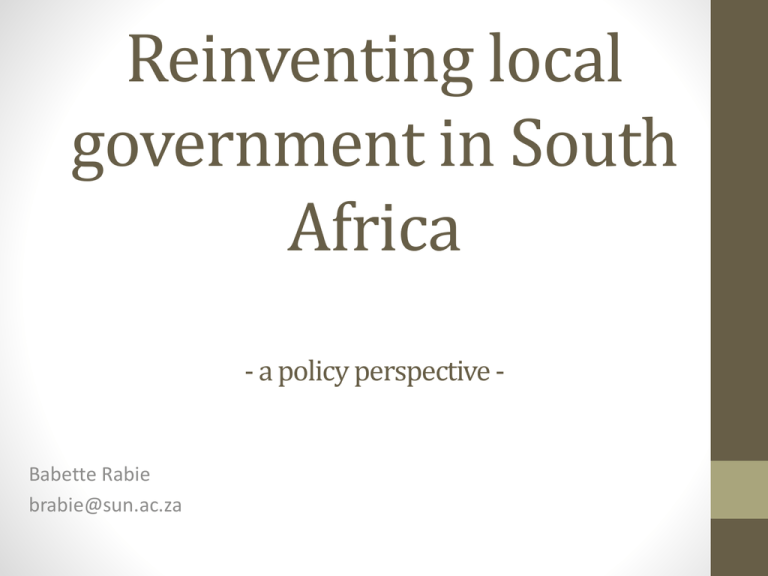
Reinventing local government in South Africa - a policy perspective - Babette Rabie brabie@sun.ac.za Introduction • History of South Africa • Segregation policies prior to 1994 • Democratisation • 3 spheres of government • 1 national, 9 provinces, 278 local • Reinventing local government • Developmental mandate • Governance, management and performance orientation The Constitution (1994) Constitutional principles for service delivery: • The promotion and maintenance of a high standard of personal ethics. • The efficient, economic and effective use of resources. • Public administration must be development-oriented. • Services must be provided impartially, fairly and equitably without bias. • Public administration must be accountable. • Good human resource management and career development practices must be cultivated to maximise human potential. Objects of local government: (a) to provide democratic and accountable government for local communities; (b) to ensure the provision of services to communities in a sustainable manner; (c) to promote social and economic development; (d) to promote a safe and healthy environment; and (e) to encourage the involvement of communities and community organisations in the matters of local government. Delegated powers to local government (Schedule 4, Part B) White Paper on Local Government (1998) The White Paper (1998) outlines the vision for a more developmental orientated local government system. It sets out the framework and programme for transforming the inherited local government system. The White Paper (1998: Section B, part 3) identifies the following tools for realising a developmental local government: • integrated development planning and budgeting • performance management • partnerships with local citizens and partners The White Paper on Local Government (1998) specifies the four characteristics of a developmental local government as “maximising social and economic growth; integrating and coordinating government/business non-profit sector activities; democratising development through empowerment and redistribution; and fostering "social capital" at the local level via a leadership approach committed to learning.” (Swilling 1998) Local Government Demarcation Act (1998) Consolidation of local authorities, new municipal boundaries The Constitution provides for three categories of municipality. There are 278 municipalities in South Africa, comprising eight metropolitan, 44 district and 226 local municipalities. They are focused on growing local economies and providing infrastructure and service. Municipal Structures Act (1998) Section 19 of the Municipal Structures Act stipulates that a municipality must annually review: • • • • The needs of the community. Its priorities to meet those needs. Its processes for involving the community. Its organisational and delivery mechanisms for meeting the needs of the community. • Its overall performance • Provides for the establishment of Ward Committees. Municipal Systems Act (2000) The Municipal Systems Amendment Act, 2011, (Act 7 of 2011), aimed at professionalising local government for improved service delivery and performance management, while also instilling a people-centred local government mindset in municipalities. Chapter 6 requires municipalities to: • Develop a PMS. • Set targets, monitor and review performance based on indicators linked to their IDP. • Publish an annual report on performance for the councillors, staff, the public and other spheres of government. • Incorporate and report on a set of general indicators prescribed nationally by the Minister responsible for local government. • Conduct an internal audit on performance before tabling the report. • Involve the community in setting indicators and targets and reviewing municipal performance (RSA 2000: Sections 38 and 41). Further financial and governance reform • The Performance Management Regulations of 2001 • The Municipal Finance Management Act (Act No. 56 of 2003), regulating financial management, accounting, supply-chain management, reporting and budgeting • The Traditional Leadership and Governance Framework Act (Act No. 41 of 2003), providing for relations between traditional leadership and municipalities • The Municipal Property Rates Act (Act No. 6 of 2004), regulating property evaluations and taxing • The Intergovernmental Relations Framework Act (Act No. 13 of 2005) , better prediction of relationships between spheres of government Project Consolidate Project Consolidate was a two-year national intervention (200406) to support municipalities lacking the expertise to discharge their mandate to provide basic services. It also sought to address the fact that national and provincial departments were not fulfilling their constitutional duty to support municipalities. Project Consolidate deployed technical experts to 136 municipalities – generally in rural areas or former homelands which had the highest backlogs in basic services and were economically depressed (Department of Provincial and Local Government, 2006a:1). The Local Government Turnaround Strategy • The Local Government Turnaround Strategy (TAS) emerged from COGTA’s assessment of the state of local government in 2009 (COGTA, 2009a; COGTA, 2009c). The report found that while local government had contributed to democratisation, the system as a whole was ‘showing signs of distress’ (COGTA, 2009a:2). Indicators of this distress included ‘huge service delivery backlogs’, a breakdown in council communication with and accountability to citizens, political interference in administration, corruption, fraud, bad management, increasing violent service delivery protests, factionalism in parties, and depleted municipal capacity (COGTA, 2009a:13). These were symptoms of deeper systemic problems in local government and cooperative governance (COGTA, 2009a:9-10). In some cases ‘accountable government and the rule of law had collapsed or were collapsing’ due to corruption, profiteering, and mismanagement. The Local Government Turnaround Strategy (continues) Five focus areas: • service delivery • governance • financial management • infrastructure development • fighting corruption. Improving Municipal Infrastructure At the end of March 2013, the Municipal Infrastructure Support Agent (Misa) deployed 68 technical consultants and 24 service providers that support 100 priority municipalities. During 2012/13, Misa technical consultants accelerated 862 infrastructure projects Municipal Infrastructure Grant aims to eradicate municipal infrastructure backlogs in poor communities to ensure the provision of basic services such as water, sanitation, roads and community lighting. Back to Basics (2014) 5 pillars • • • • • People first Service delivery Financial Management Governance Capacity building Conclusions • Local government is acknowledged as the crucial peoplegovernment connecting point. A well-capacitated local government is crucial to ensure service delivery. • However local government often lack the human resource capacity and financial capacity to fulfil the vast need of communities. • Basic service delivery (‘survival’ is a challenge in smaller municipalities, leaving no room for ‘advanced’ functions required by some of the reform strategies. • Too many reforms… leaving little time for proper implementation and measuring results.
